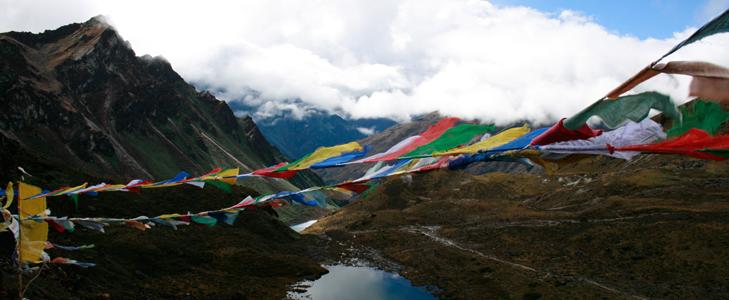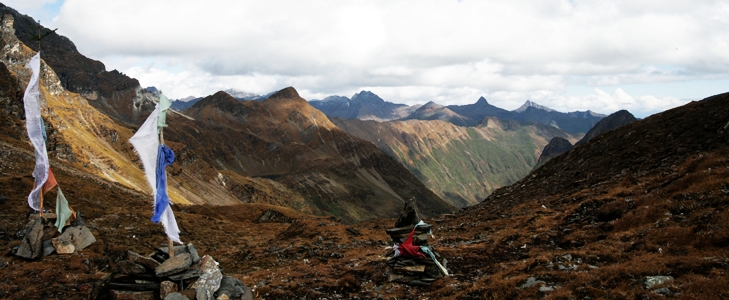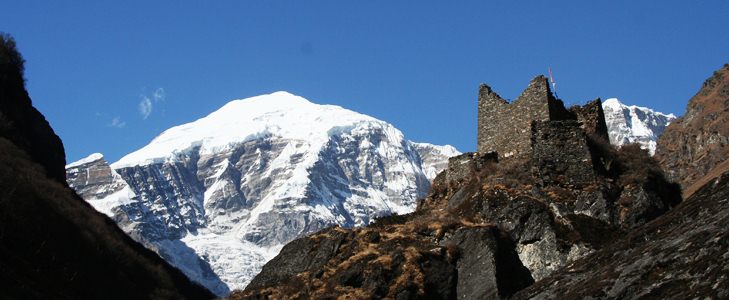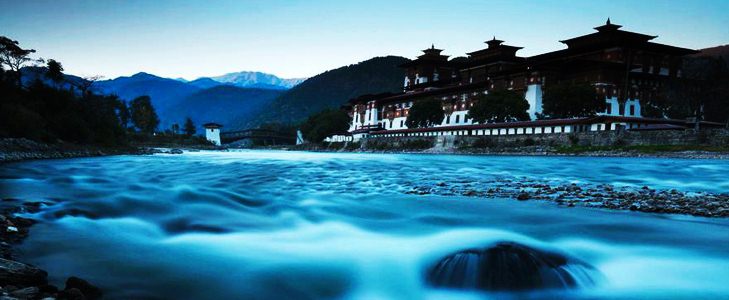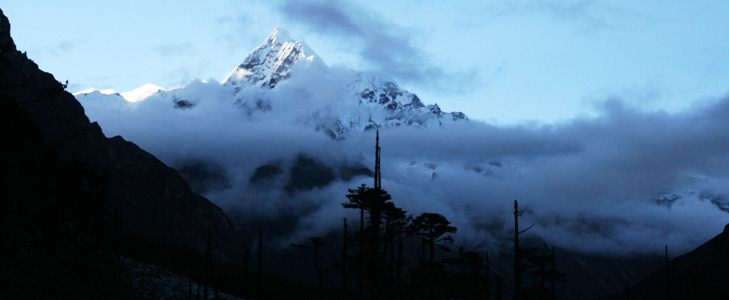In Summary:
Duration: 10 nights / 11 days.
Accommodation: Hotels, Resorts and Tents.
Activity Type: Walking, Trekking & Tour.
Difficulty Level: Miderate.
Group size: Minimum 2 pax
Best Months for the Trek: January – May, September –December.
Popularity Rating: ****
At 3000 meters, Phobjikha Valley is in one of the few glacial valleys in Bhutan. It is the winter home to the rare Black–necked Cranes which come from the Tibetan Plateau. The valley of Gangtey is one of the most beautiful places in Bhutan and the Gangtey Gompa monastery is the only Nyingmapa Monastery on the western side of the Black Mountains. This moderate trek passes through the village of Gogona and Khotokha, through meadows and fields, then forest of juniper, magnolia, and rhododendrons. This is one of the finest low level treks in Bhutan.
Itinerary
Day 01. Arrive at Paro, 2280 meters, by Druk Air: The flight into Paro is a befitting introduction to the spectacular beauty of Bhutan. In clear weather, you will be able to see some of the world’s highest peaks as you fly into Paro. As the aircraft prepares for landing, you will be surrounded by the lush green valleys. On landing, your Bhutanese escort from Druk & Drukpa Travel will greet you at the exit terminal, and then drive you the short distance to the Hotel. After Lunch, you will visit Ta Dzong, an ancient watchtower, now the National Museum. Just below the Museum is the Paro Rinpung Dzong, the centre of civil and religious authority in this valley. A short walk takes you to the base of the Dzong and across a traditional cantilever bridge. Dinner and overnight in a hotel.
Day 02. Paro, 2280 meters: Excursion to Taktsang Monastery: After breakfast a short drive will take you to Satsam Chorten, from where you start your 2-hour hike to view the spectacular Taktsang (Tiger’s Nest) monastery. The trail climbs through beautiful pine forests. You will stop for a rest and light refreshments at the Taktsang Zakhang (cafeteria) and then walk a short distance until you see, clearly and seemingly within reach, the famed Taktsang Monastery. Built in the 1600s, this incredible monastery clings to the edge of a sheer rock cliff. It is said that Guru Padmasambhava, the tantric mystic who brought Buddhism to Bhutan, came to Taktsang riding on a tigress. Lunch will be served at the cafeteria, followed by the walk back to Satsam Chorten.
After lunch, we will drive you to the ruins of the Drukgyal Dzong (Victory Fortress) about 16 km away from Paro town. Built in 1647 by the great Shabdrung Ngawang Namgyel, father and unifier of medieval Bhutan, the dzong was destroyed by fire and has been in ruins since then – an evocative reminder of the great victories it was built to commemorate. On a clear day you will see an unforgettable view of Mt. Jhomolhari (7,314 m), the highest unclimbed peak in the world. On the way back, visit Kichu Lhakhang that was built in 659 AD by the Tibetan King Srongsen Gampo. In the evening, drive to Thimphu. Dinner and overnight in a hotel.
Day 03. Thimphu Sightseeing: The day begins with a visit to the National Memorial Chorten (1974) built in honour of the late King Jigme Dorji Wangchuck, and the Dupthop Lhakhang, one of the few surviving nunneries in Bhutan. We then visit the National Library, which displays ancient Buddhist manuscripts, and the Traditional Painting School where traditional art is still kept alive through instructions in the art of Thangka painting (sacred Buddhist scrolls).
After lunch, we drive to Buddha Point to see the tallest Statue of Buddha in the world. We will then visit Changangkha Lhakhang and Takin Preserve Centre. In the evening, we will visit the Tashichhodzong, seat of the government and the Central Monastic Body, including the summer residence of the Je Khenpo (Chief Abbot of Bhutan). Then we will visit the Handicrafts Emporium followed by shopping for souvenirs in the shops of Thimphu. Overnight in a hotel.
Day 04. Thimphu – Punakha: (76 kms, 3 hours drive). After breakfast, we will drive to Punakha via Dochula Pass. If the weather is clear, we stop for a while at Dochula Pass to view the higher Himalayas. On the way, we will stop a while to view Chimi Lhakhang, known as “the Temple of Fertility”, and built by Lama Drukpa Kuenley (the Divine Madman) in the 15th century.
In Punakha, we will visit the Punakha Dzong built in 1637 by Zhabdrung Ngawang Namgyal and located between Pho Chu (Male River) and Mo Chu (Female River). For many years until the time of the second king, the Dzong served as the seat of the government. The construction of the Dzong was foretold by Guru Rimpoche who predicted that a person named Namgyal will arrive at a hill that looks like an elephant. There was a smaller building here called Dzong Chu (Small Dzong) that housed a statue of Buddha. It is said that Zhabdrung ordered the architect, Zowe Palep, to sleep in front of the statue, while Palep was sleeping, the Zhabdrung took him in his dreams to Zangtopelri and showed him the palace of Guru Rinpoche. From his vision, the architect conceived the design for the new Dzong, which in keeping with the tradition, was never committed to paper. The Dzong was named Druk Pungthang Dechen Phodrang (Palace of Great Happiness). Punakha is still the winter residence of Je Khenpo and King Jigme Dorji Wangchuck convened the First National Assembly here in 1952.
Day 05. Punakha – Gangtey Gompa: After breakfast, we will drive for 2 hours to Gangtey. On the way, you will visit Wangduephodrang Dzong. Later, explore the Phobjikha Valley famous for the rare Black – necked Cranes. Dinner and overnight in a Guesthouse.
Day 06. Start of Trek: Phobjikha – Suibikha
- Starting Point – Tshikopang (2900m)
- Lunch spot – Yaklam
- Camp – Suibikha (3860m)
- Time taken – 5-6 hrs
- Difficulty – moderate, gradual ascend
- Attractions – beautiful landscape, flora and fauna sightings (rhododendrons, pheasants, etc.)
Day 07. Suibikha – Gogona
- Starting point – Suibikha pass (3860m)
- Lunch spot – Pangeymo
- Camp – Gogona (2950m)
- Time taken – 4-5 hrs
- Difficulty – moderate, gradual descend
- Attractions – beautiful landscape, flora and fauna sightings, visit to Gogona cheese factory, possibility for a traditional hot stone bath since the village has a source for Menchu (medicinal water)
Day 08. Gogona – Khotokha
- Starting point – Gogona Village
- Camp – Khotokha (2600m)
- Time taken – 5 hrs
- Difficulty – moderate/ easy
- Attractions – Scenic beauty (view of Mt. Jumolhari can be sighted from Shoblaa pass, for example), Khotokha Valley, Black-necked Cranes can be seen during season, potential day hike destinations (valley surrounded by many monasteries and temples)
Day 09. Khotokha – Rubisa (Wangdue)
- Starting point – Khotokha
- Camp – Rubisa/ Wangduephodrang
- Time taken – 5-6 hrs
- Difficulty – moderate
- Attractions – beautiful valley of Wangdue and parts of Punakha can be sighted from almost all parts of the trail, with magnificent view of Mt. Jumolhari, Mt. Gangkar Puensum and other snow capped mountain ranges
Day 10. Wangduephodrang – Thimphu: After breakfast, drive to Thimphu. After lunch, hike to Cheri Monastery. In the evening, free for shopping.
Day 11. Departure: After breakfast, drive to the airport and farewell.




